Chapter 18. Protostars
18.1 Introduction

Author: Kristen Miller
Editor: Grace L. Deming, University of Maryland
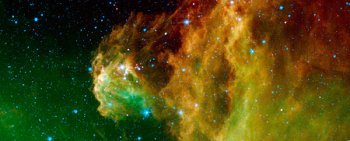
The goals of this module: After completing this exercise, you should be able to:
- Explain how the star formation process begins.
- Define what distinguishes a "protostar" from a "star."
- Explain why protostars are observed using infrared telescopes.
In this module you will explore:
- The stages a protostar passes through in its journey to become a star.
- The relation between disks, jets, and Herbig-Haro objects.
- How star formation differs for protostars of different masses.
Why you are doing it: The process of star formation gives us a glimpse into our past, helping us to understand how our star (the Sun), our solar system, and even our planet came to be. With the advent of powerful telescopes such as the Hubble Space Telescope and the Spitzer Space Telescope, we are able to probe and understand the star formation process in more detail than ever before. The mysteries of the star formation process are literally unfolding before our eyes!
18.2 Background

In order for star formation to occur, the force of gravity of a clump of material must be stronger locally than pressure, which causes the material to fly apart. Why do gravity and pressure work against each other? Basically, gravity always tries to pull mass, or material, inward toward itself. Pressure, on the other hand, is caused by the thermal motion of the material itself; this motion works directly against gravity by keeping the individual atoms and molecules moving randomly around. The higher the pressure, the faster the material moves, and the harder it is for gravity to keep it clumped together.
It is easiest for gravity to overcome pressure in regions where density is high and temperature (and thus pressure) is low, such as dark nebulae like Barnard objects and Bok globules. Even in these regions, however, the fascinating process of star formation does not begin spontaneously. It is triggered by a nearby supernova explosion or by passage through one of the spiral arms. Such events squeeze the material of the cold dark nebula, allowing the mutual gravitational attraction of the dense clumps within the cloud to overcome the forces of pressure and begin the collapse. Once contraction is initiated, the cloud will continue to collapse until a star is born.
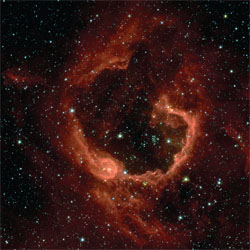
The upper figure on the right shows a star forming region in our own galaxy that was triggered by a supernova explosion. Star formation can also be triggered by compression of a cool region as it passes through one of the spiral arms of our galaxy. Spiral arms are higher density regions, which encourages compression of gas. Once star formation begins, the development of O and B main sequence stars can trigger new cycles of star formation with their strong winds and radiation, as shown in the lower figure on the right.
In the following pages, we will explore in detail what happens as a clump of material begins its journey to become a star. We will first look at the formation of an approximately one solar mass star and then discuss how the formation of higher and lower mass stars differs from that of a star like our sun.
Question Sequence
Question 18.1
1ry9dfsGkgNBnI3/Iz+Uyy985y6sUZ+lOaMMq/1U8ojxqLHvt3Ovcs1PIcqwHbzyGwKX16qHyNV5gEp8yXEkjOJHYgEJcG7XGeEQIYJCpUHwi/cQTthT6KgVY4iO3DyQW1NTK8IpDa38PvwR6wZZZw+ANhtdUVttjFBvfnQ/wqlBV6VRAVVCjkEi448M83BWQWoBeC87UXDBCRl/LazcCEU/mWVqpC9sxUKx1kdu/zbvWUWhnQZ7vD9TRQcHp1xLygYdvoxp/Q49ZDAuzISlMjFJQGS0T//97MxlO2DQqDYkXkXcTjS4mslVQeNhBsBfD7abKXaI1PYQWosSudxmBZBGbYg=Question 18.2
l5mpZpJuy+V6/s940NQw/Q7Ih1kNkmaTO1tu/eXhOcNiUJJL+9eqlicT2N5YyHm1hv4twM79qBKozt6wjc83VXlGkn6kPurFok+fidlc9rQrbWAN2ijDH+FIf0U0GI/XIU4KcMqhmJNoNwIarXHOLvQrC8g=18.3 The Collapse Begins
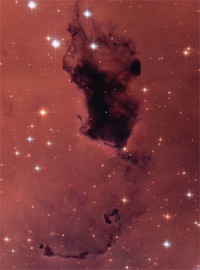
As a clump of material collapses, gravitational instabilities develop, causing it to fragment. Each fragment continues collapsing, but they too develop the same instabilities and each fragment subdivides further into smaller clumps. This cyclic process continues until the density in the core of the fragment is large enough that radiation can't get out easily. At this point, the mini-clumps become stable and fragmentation ceases. Typically, a single condensing cloud will either fragment into a few dozen large clumps that will become large stars, or it will fragment into hundreds of clumps with masses comparable to, or less than, the Sun. In this way, most (if not all) stars form as members of groups or star clusters.
Fragmentation is the first stage of star formation. It takes a few million years from the initiation of the collapse until the time the resulting fragments, which will eventually become stars, reach stability. During this entire time, each fragment continues to collapse, its radius decreasing and its core temperature increasing as it does. In the rest of this activity, we will focus on a single, stable, collapsing cloud fragment.
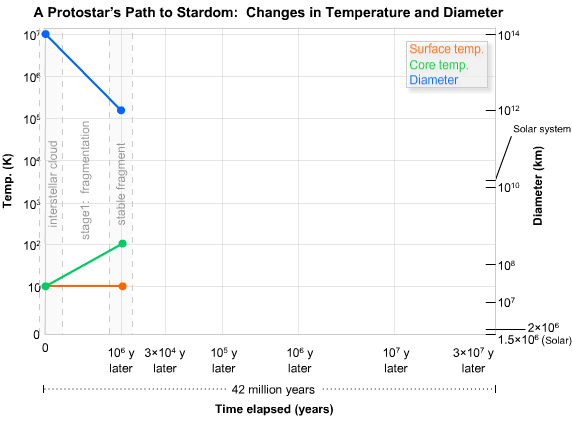
Question 18.3
CUthApora26vHG3qUrAsRDkyAX3EZ3XlWzGRYpoqxZO8Gg6LAd7e1jyJecPFsS2uXDS2PJ/3x/kpCj7rGytlAfgx39zcH94ltulZcMSJ5yXpMCSxHiWshxBS2869sP33vChvZQnZCcubNqHU5FsnIGjaOeMgAzHAd5FmmjH+qn+1OFD6bJnEP/j8FTZAFo0K18.4 A True Protostar

Although our fragment is now stable from further fragmentation, it is still collapsing. Generally, when an object collapses, the gravitational energy of the infalling material is converted to thermal energy, heating the object. However, while it is much denser than the average density in the interstellar medium, the material in the fragment is still very thin, so most of the heat generated by the collapse simply escapes. This is why the temperature inside most of the fragment is that of the parent cloud. Only in the core of the fragment is the density high enough to trap a portion of the radiation generated by the collapse, raising the core temperature slightly.
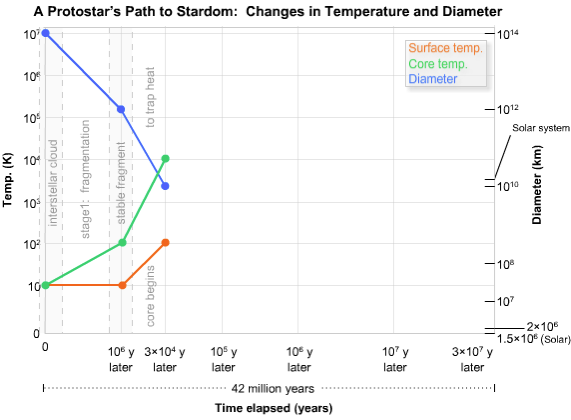
The fragment continues to collapse, slowly trapping heat in the core, for tens of thousands of years. Finally, the core becomes dense enough to trap all of the heat being generated by the collapse. At this point, we say that the core is opaque to its own radiation. From now on, the core temperature will begin to climb rapidly even though the outer regions of the fragment, where the density is still very low, remain comparatively cool. For the first time, the collapsing fragment can be described as a protostar. Its surface, or photosphere, can now be defined as the radius inside of which the material is opaque to radiation, or heat. The graduation from fragment to protostar occurs approximately 100,000 years after the fragment first forms.
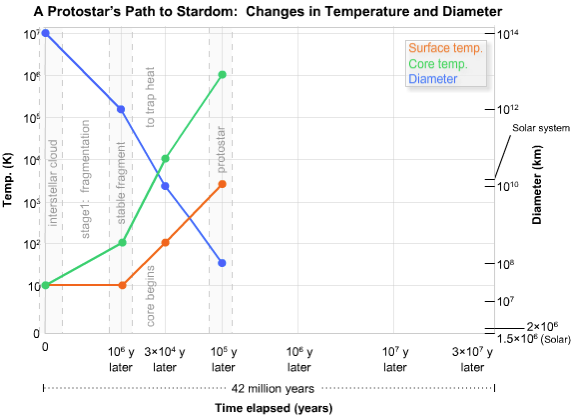
Question 18.4
+i3/BD9RSZZyidK78+nC9iYsHqJcyL1R2k6ARt/HrwrjNYnt4+WKJBDLn6Rg8DTcfElnxiT8GWZqFaznjZuEJBjTmcCflgI43+JCDiAh39m7ZtgFLQqjSzAdTs7S9SC1BpiswFxlUZFF6DuWBTn2a3eViNT1HwyKFCu8K+5FMnLIF7qVEzPqV/R/OifSneTLamqNGVLz1gmxZntc6DY+SoFgVLUvHztkZTqCYOFqk5DZ6luIfI2JVv0dffrJgNGFLMCmRaOKlpblXLZCkV8YhLC16AN4nqCQ5iptp7cYUpVCu6oRy5ryt/JOI+yFSRQeS8PHi5hCFLwqay3or+ya5esb6nhAepwf2Fw51mRpKHfak2BSlqrEkUMk5xJtudU1EwDpkOn0oypPVpstItcbhZXOLzJBGcD5+uWikXBwSEw=18.5 Protostellar Properties
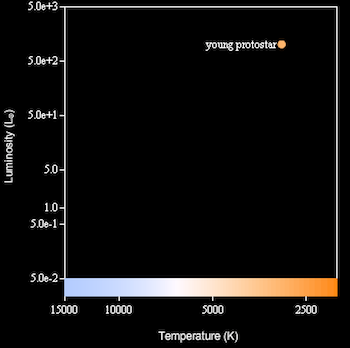
At this point, the protostar can be plotted on an HR diagram. With a surface temperature of a few thousand Kelvin and a diameter 108 km, its luminosity is roughly one thousand times that of the Sun. (Note that the protostar's luminosity is due entirely to the release of gravitational energy due to the continuing collapse - not to fusion as in our Sun. The protostar is still too cool, even at the core, for fusion to occur!) With a high luminosity and low temperature, the protostar enters the H-R diagram on the upper right, as shown to the right.
Although protostars are very luminous, they are difficult to observe because they form inside dusty clouds. The large amounts of dust, referred to as a cocoon nebula, surrounding a young protostar effectively block the visible light it emits. As the dust absorbs the light from the protostar, it is warmed and re-radiates the energy at infrared wavelengths. Observations at infrared wavelengths allow us our first glimpses of forming protostars, as shown in the figure below.
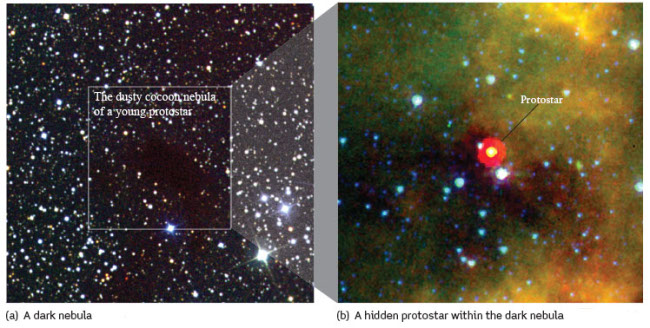
Question 18.5
tI53NxsTbvYygEXbMQHygKqlrHDhYTV7AzZtuDpQSExmfe/iyUEsCXiZ4xyL63sgL186V5Es8XPU3BX2C7YgKKZuqXmOteM++5BkQRUONLIqg2CSzMFpUN8wxBt+Ke92WTK8GHjmEyMHmGTWJyzrNLRpFCtqtpSy75bzdiABuh2JQchS18.6 T Tauri Stars
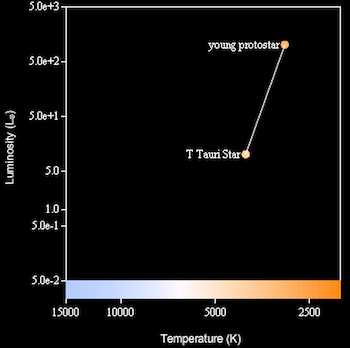
As the young protostar continues to collapse, its temperature increases and its luminosity decreases. The decrease in luminosity occurs in spite of the increase in temperature because the radius of the protostar is decreasing rapidly. We can chart its progress as shown in the graph to the right and below.
At this point, the protostar is roughly ten times the radius of the Sun. The gas in its core is completely ionized, but it is still too cool for fusion to begin. Its contraction continues, but at a much slower rate due to the decrease in luminosity. This is because, in general, the speed of the collapse is governed by how fast an object can radiate its heat, and lower luminosity means that less energy is escaping.
This stage of a protostar's evolution, known as the T Tauri phase, is characterized by violent surface activity, which leads to the ejection of a significant amount of material. T Tauri stars have strong winds and jets that eject up to 2 × 1023 kg, or 200 million tons, of material each year - this is more than 10 million times the amount of material our Sun currently loses yearly! Over the entire span of the T Tauri phase, a protostar may lose roughly one solar mass of material! T Tauri stars are surrounded by a disk of material, called an accretion disk. Accretion disks form because the material that is condensing to form the protostar flattens as it contracts due to the fact that it is rotating. The ejection of material via winds and jets helps to stabilize the forming star as it accretes material from its disk.
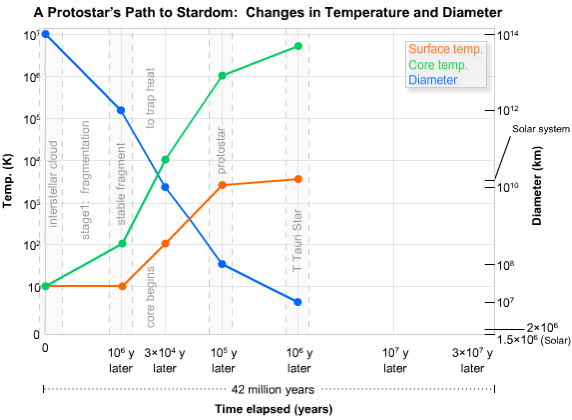
T Tauri stars also have very strong magnetic fields. These magnetic fields play a role in the formation of the protostar's jets via an interaction with its accretion disk. Such jets move outward at high speeds on either side of the disk without much spreading; we say that they are collimated, or contained in a narrow volume as they travel. When they collide with the interstellar medium, they create glowing knots of gas which are known as Herbig-Haro objects (HH objects). Accretion disks, jets, and Herbig-Haro objects have all been observed around protostars, as shown in the figures below.


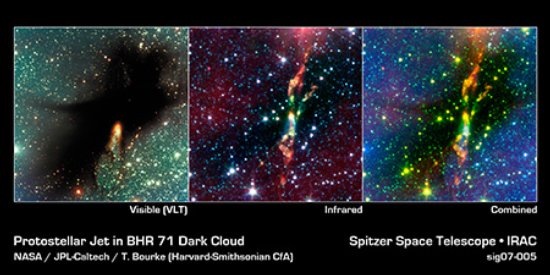
The following animation shows how magnetic fields interact with accretion disks to produce protostellar jets.

Question 18.6
o0re3aAG5fZvN+oS2U8QWj11WBMpxtSYFmufEWvoPb459JwjcaZxRR5RzT4hTZN0iggvw64MiulBOyT/ffQcOY1JLOqPlfCVdts8nn2py0wibvxXBK6u6690NeTDAz9ddWPKLztOrv+83uPksA4hHEi/NsGmVOZUA1GgSTX2k2D3AiBz052PYiAcr6WhCZa8wM9HdFvVUY6wyJxI/0CacYCakayslfdJ18.7 A Newborn Star
Ten million years after the protostar forms, it officially becomes a true star - this means that it is finally powered by fusion! The core of the new star reaches a temperature of ten million Kelvin, hot enough for fusion to begin although still cooler than it will be when it reaches the main sequence. It is larger but cooler than our Sun, with a luminosity that is slightly lower, about 66% of the Sun's luminosity, as shown on the graphs below.
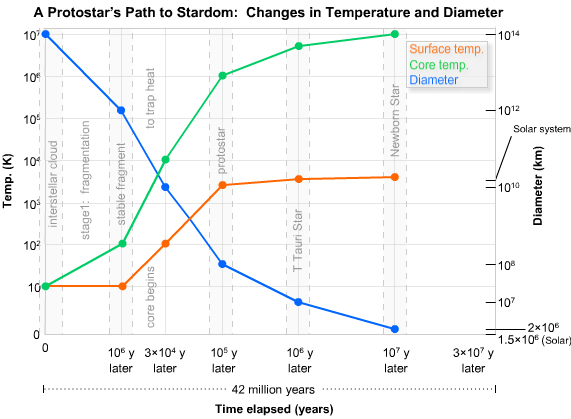
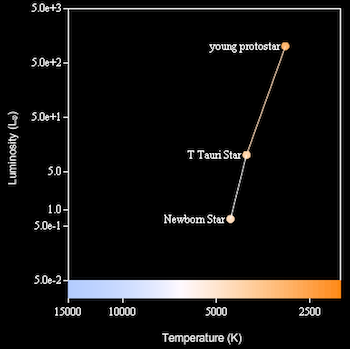
These young stars are found in the dusty cocoon nebulae in which they form, as shown in the following figure.
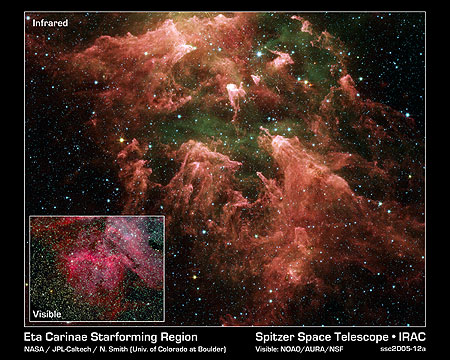
Although fusion has begun in the core, the star is still contracting. Thirty million years later, it will finally reach equilibrium on the main sequence. Equilibrium means that the rate of energy generation in the stellar core created by fusion will be exactly the rate at which energy is radiated from the surface. When equilibrium is reached, the contraction will finally stop. The star's properties are shown on the graphs below.
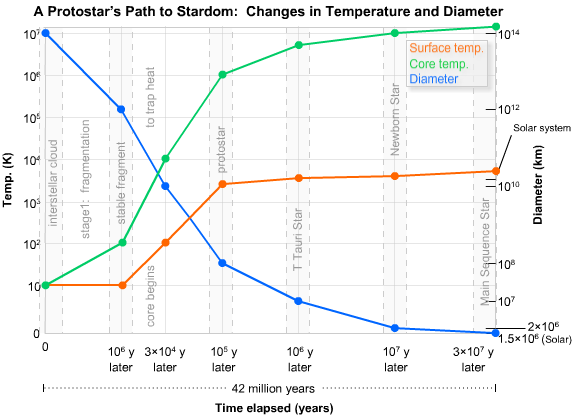

The star is now stable, and will remain so for roughly 10 billion years. In all, the total time of the collapse is not quite 50 million years, less than one percent of the star’s main sequence lifetime. Its journey from cloud fragment to main-sequence star is summarized in the following animation.

Question Sequence
Question 18.7
K43kj8I+Ia2FDm5jwdjwc0BDSCMGMqix6o+jJh3usrGsM2ImOAcHjcVKmy7WHIXTU1NYFilCFNk6+q4HGqA2r8Hq/kFAzOOYLvNtpCdQlEDLJebjTJJg/FI7d7+UN8ihoPjBy0U+d5yjWFYxuje1davrR+uyiViWGHw19B1HkiA=Question 18.8
EBcnhuCM1EFQnQo1PXe3va4Nfq4X7htr9r7YUyYt8k1tdOzWnmaGbO/Z1psPOVWy/IEaT/Qd+roZp4ycet5R353eLyvhz6QIuRv8C8YB8nu3RSQyoKTOPV+UDH9R8fvY+E4GGI3sqJgckxlp6D+yvKOH4iD1KPU0snrAYxsltax6U8fcFghk5s4HoaBCTTdb3zWAXWvsP2+yK21ajnwqRExtNx823tAhKQwpdf4ysKtdnidCUmOshYxaSLPOf6ydxn/Xm298yln4/1BtKWUo+ujyDsstw2ZaKWS9e3q+DgxffqtmLCGbXqbwttt5TU7jao4X6CQNuTHLy3b0f9SNKiY5PBZldUWsbxz7LQvNzf8NfRT8NVWYksEUTQtCb0dyGs+iK+fX4VU8LbzO5WK1qZs6QnfZuPRGL5dgtHkXN6xJ4NxeusXRpFrqnWBwZXzp8Lj/RgjFg1ZDjz4VdeS3a9YOw0eSTAAGeqySe1qOt/Lv3mNnjGfBTmXfLxWnCKyXsdyLopD70a/ul6FvSvrZwB2XMP6BWfAHsQaP/flr+VKIgrgPsXknJ4YhNhhrudlPVh/LX+aSbjqdEzu3e9+OT7mwn79/8lkNyW477UeRqXsNwuroVz76ilrTpMhL5z6aZ1URXw==18.8 High and Low Mass Star Formation
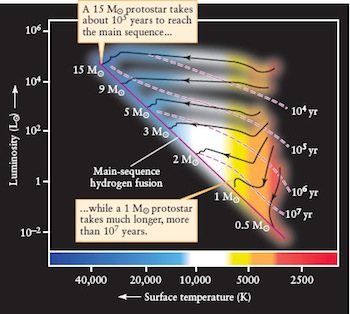
In this activity, we have looked in depth at the formation of a star like our Sun. Now, let’s look at how star formation differs for stars that are much more massive or much less massive.
One main difference is the time it takes for a protostar to reach the main sequence. As a general rule, the more massive a star is, the faster it evolves. So, while it took our solar mass star approximately 40-50 million years to reach the main sequence, it takes a 15 solar mass star only 100,000 years, while 0.3-0.5 solar mass stars take nearly one billion years. Part of the reason for this difference is the fact that a more massive fragment has a stronger force of gravity and thus collapses more quickly. Another reason is that the interiors of stars of different masses transport the heat produced by the collapse in different ways. Because a protostar's ability to contract is determined by how quickly it can radiate away the heat produced by the collapse, the energy transport mechanisms involved play an important role in determining how quickly the star evolves. The way energy is transported through their interiors is the second main difference in the formation of stars of different masses.
Energy transport inside a solar mass protostar occurs via convection due to the low temperatures in the collapsing fragment. Because convection is such a slow method of transporting energy (compared to radiative transfer), the fragment progresses slowly through the stages of star formation. This slow transfer of heat also causes the surface of the protostar to remain fairly constant as it contracts, while the interior heats up rapidly. When the interior is hot enough that all of the material is ionized, radiative transport takes over very deep in the interior, and the protostar’s luminosity increases. This layered structure remains in effect even when the protostar becomes a main sequence star. This is shown in the H-R diagram above.
For a high mass protostar, the situation is different. The larger mass creates higher pressure and temperatures in the core, which creates a large temperature difference between the core and the surface of the star. This means that convection becomes the dominant energy transport mechanism in the deep interior of the protostar. The outer layers have very low densities, so radiative transport dominates there. This means that energy transport in the interior of a high mass star is essentially the opposite of that in a low mass star!
The high temperatures and pressures in the core also mean that fusion begins much faster in a high mass protostar, so its luminosity quickly reaches its main sequence value. The evolutionary track of a high mass protostar is almost horizontal on the H-R diagram, with its luminosity remaining nearly constant while the protostar contracts and the surface temperature rises. This is also shown on the diagram above.
For very low mass protostars, the interior temperatures are never high enough to fully ionize the material, so convection is the main energy transport mechanism throughout the entire star during all of its formation. This means that its surface temperature remains low during the entire process, and also explains why its evolution is so slow.
The differences in the interiors of protostars of varying masses is summarized in the figure below:
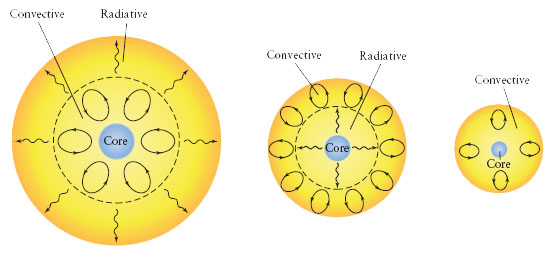
Question 18.9
lCKOKB4lrpHmflmZWFZesIZz4OHxBu13SlFJQ8ZDFq/MWeT4LcPdO6klCXuGvWiLmBY8g8xY7yFZSYPHxwlTVlPB/0t4ahHq7wKi6vJBp+N+fuB8MISPDSBzgeaZW8BLzkn5h2t4tLqnqapXcLuFpp+XPA138TcWs7+HLLyfPqhLXrsOVbuEXwy4R1aVcrCNL2VQSqBwP1CQ447IV49oUWXkODHSFHxgieDF/sJYLkyLJ9DchPD7Ncn05489KTto4Am7yLpsd5+pagnHiTnQxQPlQzGL93k24c7ENPeVf4sW97ppEh3H0AeORTDWrpRJXjgXeFf4DS+XXfYS4yAiJng0iKNAgJB+OIyhfCpm4Kjx10zCDumZ1loSO29pLZdyB12xCe6opejCOPCfQUzN3Z8qbaE=Question 18.10
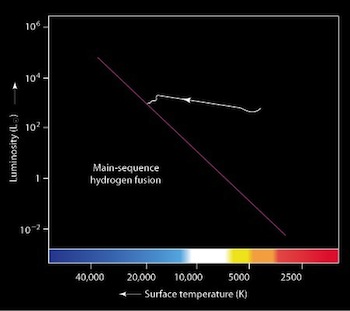
18.9 Quick Check Quiz
Indepth Activity: Protostars
Question 18.11
ajd/dyuRw1LGYg/emVtZ7eSnAmoS9e5k3TGpOqB4Alv0naRoIDqokAunHA8ObLA+NZ8WOMti3MaPsdhJMO5LN1rgryAbG8TMPcbcB9XNg2DtI9Mp1uN0pZRqDj1BVVw7DxmhctThkPbATsOfXcdW4NSReqJy17nDLCg2zDbyTESJIZIJTh7dxKxGc3b6UPRcIi/QdXn+0/WWVoxaxR5eVsYGziT0GsqcXaU7JTc7OJwhAFmoA9Fzn/LbLnhB6iL1vbT1nWmbv/eE3WO+rMnE+OYZmn8tIb4E/HqW3YkPa8W/DX83fvYppxcm+E9x1Sfv8H2lTOXocPYOnL40LcXMoV2QQ7D5j7SUnfcyFBCDvH6yr59eUgi4zt57K4X2xcddq6S/GzVHnzX7ZIzdYgfw154C+9VOZjRWQuestion 18.12
O7fl1JdiRiqRB40DjJh47IBhiswegbNLjMROjhfPRG/MsLJgP/6igxHxxa2b3WV7IOCgWXfFUsWeEQZehWoz7kA6IV5NtvP7g7omB7I1oVELaWvwDvtNG/W3EW7vpQzLtoYFXH7uDSPGarX9zSFufsQ8YhxbFZarD4n+umDKoETlfzGXDJAyWV0TeGBC0opdRQZb6GZNbPsDsYSl68Ln9JRW/4IyTpokGKeG9Y/fgUXFpb7urcNI8U9BcZv04Nv3sPqZNH59u2irVhCWlsLxblx7VPOQWZnfS7abSqop6gl6KWSfz6sSLO+aNsq1/i4f9bmw9QiBINf/0/mIsZ0sMskloVPbgUadfdyy7w6ii69YY5Vky8NZ1Ij76kHlzP251N0AzWhBnXMpnDkyLFwgQ0sRFyrchC0v64bnGdGcPmKJyVhYx5GGTGYtluCBtjE/cwjb0A==Question 18.13
2vRGBOFW49izqG7bnXqyYvDr6iPhx19O/8pL756FNXLnPznb1SPdNYQVwfsCVle0IyNYsfsVTndLTIdZcgYLPww8uJdT2y70tLnND8qGgomM0q7o4q6ny0xh8lbhBqWimKDaw4YcRLhtnosm2CImQu8BKQYVEPVCFZ5NUw24txbQJPeu7WICIdXZuZyHgc4khE12Y1k6+HSBPseofIonOc/H2Np+PHjlrB4rOWMNfdqqjLEWXxWONV3JydfH4w8INJJUKC9LlLUV+/QQk5csdtEw7X6mX4lms0u4ZsEaZnxDGKBxCOKy/0eH8wUEI2PWgan0cJLHUIS0xEImaMeq43pvD3BBcCy0PDJwGeLVenbRVOlLJF+zl8pf0ey01QwxSGUI4nO860cNEtqvQuestion 18.14
NhSum2VMcsMZoWcTasIERT+AjBnEyIt0Z/CsSX2SrqUDnqCAZ+GcLzryjBSo+/RYYmiFSA9RdUhWF6CWQ9XO6IrnYXTogu+bN/sA5VArydtHnFHCjaazaul+GAI1/U/iaVr+sgSI4ww09p2gQ2VmGTAoUQy8dWrexKDpimZ0zzdsMLjuCWQoudAx12AyZGVcwlMBuVtbZMrWv5L7Az5Avi53sqnyrCJrJMmggGHJPby+sCHz84ozMIco1M+p0/FwQuestion 18.15
oyaMEfgiBS1TI4X0WkjyO/YfWc3/vwFwVpVxwfDIkLphjVyEW56fclWUuodR2EZ4dMLErLzuH5KYUGucMKz403FTBfC1qHRB8nP4NtruJDARBBFcSY46HLOaOmh/kNRbJJs2GbQD3DZCNHrImJQl2PPrhP8+wTNEgDDhoaHoJiDwJ6gkKxsDtA==Question 18.16

Question 18.17
McAjUgRgDyQgwUVnJ/R+/m/5XIW1sY9Ygt3VLRM3G/gbXcCuj4M5EHLgFC6GFY1INttNSm6L26Qeh4ErxDeabcEO/6Fj7yyQY0lpBYp7bSL+lRmuy6sSv3fF3C8sxqqnQRQFpMOMYNOnMu948TrU4D7CgzAF44TxpK+82izoBtVYwN37v2RQDdc/BIdUf23JhJUscl2+LByMHVSSiWXGJztNPG/49XwivskHgI5t3+Ds8UyDq9Kg7bM8IF8U9R49egZieMiaDAFa7u8OxRY5aGW3QiZ9cyu9JN8SOQ==Question 18.18
PhddwgbmpLFYr5cbup9mwCXp8zf/h61dlp6i1BqcKSrOnKT6ldZBcYxs4EmmjDEidXshSldeTuwVYhl7xnLIU4S4sDRS/9l0P00M0VMeVb7yt4GWZ0nrvRkQR1lZgNpF7nSgHiLv0emxi6WTaByPjVfkjy9QtVXVFQ1LWG1VNJZZvyMhAbFD6QZ7oE37UIIlevluQcSF+qvn0KnYci1UXM1GWKrKN0bGbS6A4nEqYB6E/5BCIjB9FQQSPv2nLomWSC/GK09j3NuCfcbv0AyBSp43hDk=Question 18.19
